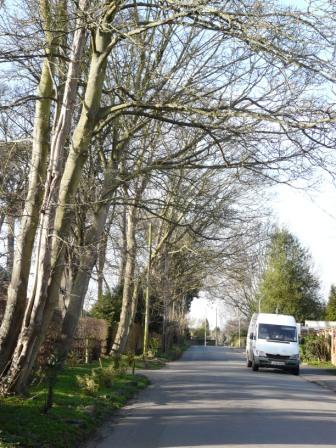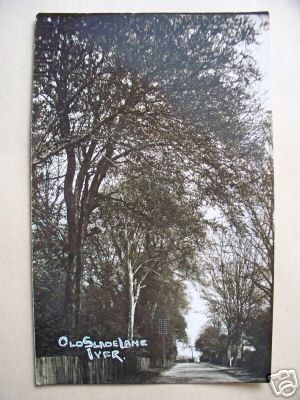
|

|

|

|

|

|

|

|

|

|
Richings Park today ...

Old Slade Lane 2011
the lane. There was originally intended to be a complete row of shops along Bathurst Walk on this land to join up with that at 18 Bathurst Walk but these did not get built. At about this time (1959) some of the land on which Bathurst Close was built was also sold by Mr Norrish. The rest was acquired from the back gardens of the houses in Bathurst Walk and Thorney Lane South. Prior to this the land had been a waste area comprising a row of lock up garages, a circular track round a gravel dump and a decrepit builder's shed in the corner closest Bathurst Walk. The 1st Richings Park Scout hut was located here during part of the war. Bathurst Close became a truly private road which is maintained by the residents.
Old Slade Lane south. This was originally an old farm track south from Old Slade to Colnbrook passing close to Tan House farm. From before the Sykes and for a time after their arrival the address of Old Slade Farm was Colnbrook. It then became a Richings
Park Estate road to its gravel pit (which eventually became a nature reserve and then reworked as a gravel pit). Only a few plots had been developed when Boyers acquired the remnants of the Estate in 1938. Plots for post war houses were conveyed to individuals by Boyer.
The Poynings. This street was partially developed by 1928 and it is rumoured that Eric Sykes lived in No 11. Further development was undertaken during the receivorship and the road was completed with a variety of brick houses of modest proportions by the builder, Cotton (of Iver Heath?) post 1945.
The Ridings. This cul-de-sac of 7 pairs of plain, rendered semi-detached houses (some thatched) was another entirely separate, private development by Rhys J. Rees, one of the builders employed by the Richings Park Company. The land was conveyed by R.P. (1928) Ltd to the builder, to develop as he wished, in September
1930. At that time the collapse was approaching and the cash flow was difficult. It may be that this was payment in kind. The designs of these houses were later replicated in other areas - The Poynings, Syke Ings and Skye Cluan. Maybe they were one of Clare's ideas for houses for agricultural workers.

Old Slade Lane
In these roads in some cases it appears that latterly properties were conveyed with ownership up to the middle of the road rather than the front boundary. It was the Richings Park Company practice to state quite clearly that land conveyance stopped at the frontage to the street, and it

